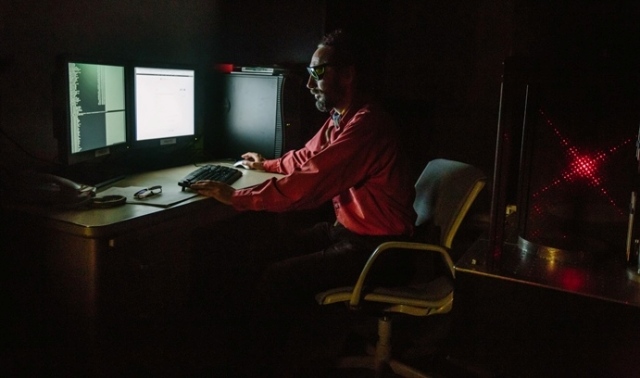An international collaboration of researchers announced a major development in the characterization of graphene’s structural strain.
 Slava V. Rotkin, professor of physics and of materials science and engineering, is working with an international research group to study the properties of graphene using spectroscopy and statistical analysis. Photos by Christa Neu
Slava V. Rotkin, professor of physics and of materials science and engineering, is working with an international research group to study the properties of graphene using spectroscopy and statistical analysis. Photos by Christa Neu
Graphene is a one-atom-thick sheet of carbon was the first 2D material to be discovered. Since its Nobel Prize winning discovery by UK physicists Andre Geim and Konstantin Novoselov graphene has gained immense global recognition for being both the thinnest and strongest material ever known. The two physicists used a remarkedly basic method to produce graphene which involved employing selotape to peel layers of grapene off graphite. However, this is an impressive task regardless considering that 1mm of graphite contains three million graphene layers.
Graphene has been celebrated as a 'wonder material' due to its exceptional properties. Graphene has a strength of 150 to 200 times the strength of steel and is an excellent conductor of electricity and heat. Additionally it is dense, flexible and virtually transparent.
Graphene is now widely being used in product development with a wide spectrum of applications ranging from tennis rackets to smartphone touch screens. According to a 2014 market report, which appeared in Nature, the US graphene market was estimated at $12 million in 2013.
However, there are obstacles to the rapid commercialization of graphene. One of which is the defects that cause strain on its lattice structure which negatively impacts the material’s unique optical and electronic properties. Consequently, this means the mass production of excellent quality graphene remains expensive.
Graphene is stable and flexible and can expand without breaking. But it has wrinkles, or bubbles, on its surface, which give the surface a hilly feel and interfere with potential applications
- Prof. Slava V. Rotkin, Lehigh University
Chemical vapor deposition (CVD) on a silicon dioxide substrate is used to produce individual layers of graphene and it is in the manufacting process that strain is introduced. Strain in the graphene product can be the result of contamination at the synthesis stage. It can also be caused by the uneven cooling and contraction of the graphene at unequal rates as a result of the graphene and substrate possessing different thermal expansion coefficients.
Slava V. Rotkin, professor of physics, materials science and engineering, states that the collaborative research findings will prove to be helpful for scientists keen on monitoring strain levels quickly and accurately during graphene fabrication. It is hoped that this information will help prevent the formation of strain defects.
Scientists already knew that Raman spectroscopy could obtain implicitly useful information about strain in graphene. We showed explicitly that you can map the strain and gather information about its effects. Moreover, using statistical analysis, we showed that it is possible to learn more about the distribution of strain inside each pixel, how quickly the levels of strain are changing and the effect of this change on the electronic and elastic properties of the graphene.
- Prof. Slava V. Rotkin, Lehigh University
Raman spectroscopes, which gather scattered light from the surface of a material, were used by the team to take non-invasive measurements from the graphene. A magnetic field was also used to increase the Ramen signal. The magnetic field manipulates the electronic behavior of the graphene resulting in amplification of the Ramen signal. The team took nanoscale strain measurements at different pixels on the surface of graphene.
The Raman signal represents the ‘fingerprint’ of the graphene’s properties. We’re trying to understand the influence of the magnetic field on the Raman signal. We varied the magnetic field and noticed that each Raman line in the graphene changed in response to these variations.
- Prof. Slava V. Rotkin, Lehigh University
The “Raman map” of graphene has a spatial resolution of nearly 500nm which enables the measurement of strain variations on a micrometer scale. It also allows the average quantity of strain exerted on the graphene to be determined.
The team presented their paper titled, “Raman spectroscopy as probe of nanometer-scale strain variations in graphene,” in the Nature Communications journal. Besides Rotkin, the other authors are researchers from RWTH/Aachen University and the Jülich Research Centre in Germany; the Université Paris in France; Universidade Federal Fluminense in Brazil; and the National Institute for Materials Science in Japan. The facilities of RWTH/University of Aachen were used to produce CVD-grown graphene samples.